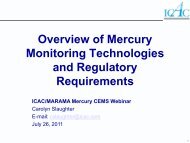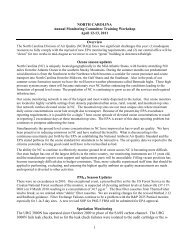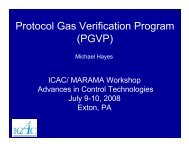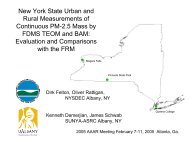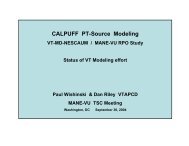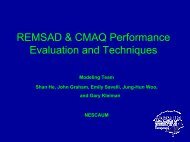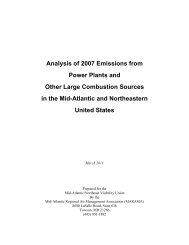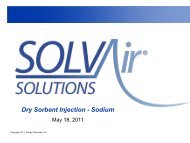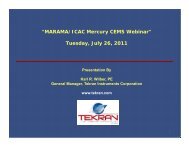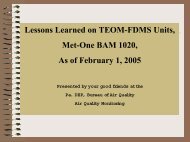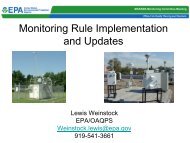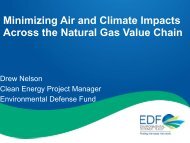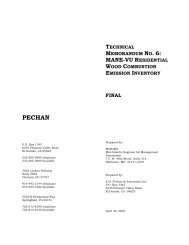NIST Standard Reference Photometer - MARAMA
NIST Standard Reference Photometer - MARAMA
NIST Standard Reference Photometer - MARAMA
You also want an ePaper? Increase the reach of your titles
YUMPU automatically turns print PDFs into web optimized ePapers that Google loves.
Ozone Measurement Traceability with the<br />
<strong>NIST</strong> <strong>Standard</strong> <strong>Reference</strong> <strong>Photometer</strong><br />
James E. Norris<br />
Maryland Department of the Environment<br />
May 18, 2011<br />
<strong>NIST</strong> Analytical Chemistry Division<br />
1
• <strong>NIST</strong><br />
Outline<br />
• Measurement <strong>Standard</strong>s<br />
• Ozone <strong>Standard</strong>s<br />
• <strong>NIST</strong> <strong>Standard</strong> <strong>Reference</strong> <strong>Photometer</strong><br />
• U.S. Ozone Measurement Traceability<br />
• BIPM/<strong>NIST</strong> Collaboration<br />
• International Ozone Measurement Comparability<br />
• Summary<br />
<strong>NIST</strong> Analytical Chemistry Division<br />
2
National Institute of <strong>Standard</strong>s and<br />
Technology<br />
is a<br />
non-regulatory agency<br />
in the<br />
Technology Administration<br />
of the<br />
US Department of Commerce.<br />
Mission … to strengthen the U.S. economy and improve the quality<br />
of life by working with industry to develop and apply technology,<br />
measurements and standards.<br />
<strong>NIST</strong> Analytical Chemistry Division<br />
3
U.S. Federal Role in Metrology<br />
The Constitution of the United States<br />
Article 1, Section 8: The Congress shall have the power … to<br />
coin money, regulate the value thereof, and of foreign coin<br />
… and fix the standard of weights and measures … (1788)<br />
“Foreign traders had begun to voice concern that goods<br />
might not be assigned a proper quantitative value at<br />
American custom-houses and that, as a result, assessed<br />
duties might be unfair and uneven from port to port.”<br />
John Quincy Adams (1817)<br />
<strong>NIST</strong> Analytical Chemistry Division<br />
4
NBS Organic Act of 1901<br />
“It is therefore the unanimous opinion of<br />
your committee that no more essential aid<br />
could be given to<br />
• manufacturing<br />
• commerce<br />
• the makers of scientific apparatus<br />
• the scientific work of Government<br />
• schools, colleges, and universities<br />
than by the establishment of the<br />
institution proposed in this bill.”<br />
• Custody of the standards;<br />
• Comparison of the standards used in scientific investigations, engineering, manufacturing, commerce,<br />
and educational institutions with the standards adopted by or recognized by the Government;<br />
• Construction of standards, their multiples and subdivisions;<br />
• Testing and calibration of standard measuring apparatus;<br />
• Solution of standards problems; and,<br />
• Determination of physical constants and the properties of materials,<br />
when such measurements, standards and data are of great importance and are not to be<br />
obtained of sufficient accuracy elsewhere.<br />
<strong>NIST</strong> Analytical Chemistry Division<br />
5
Early Driver for <strong>Standard</strong>s<br />
1904<br />
• Out-of-town fire<br />
companies arriving at a<br />
Baltimore fire cannot<br />
couple their hoses to<br />
the hydrants. 1526<br />
buildings razed.<br />
1905<br />
• National Fire Protection<br />
Association adopted<br />
NBS-developed<br />
national hose coupling<br />
standard<br />
<strong>NIST</strong> Analytical Chemistry Division<br />
6
Birth of the “<strong>Standard</strong> Samples” Program<br />
1905<br />
<strong>Standard</strong> samples program begins<br />
with “standardized irons” in<br />
collaboration with the American<br />
Foundrymans Association<br />
1906<br />
At the request of the Association of<br />
American Steel Manufacturers, NBS<br />
began work on certification of 17<br />
types of steel<br />
• By 1951, there were 502 <strong>Standard</strong><br />
Samples, 98 of these were steels<br />
• Today there are more than 1400<br />
different SRMs<br />
• ~ 32,000 units sold annually<br />
<strong>NIST</strong> Analytical Chemistry Division<br />
7
Train Derailments<br />
… Poor Quality Control<br />
1912<br />
A report by the Interstate Commerce Commission revealed alarming statistics for<br />
railroad accidents; almost 42,000 over the past decade. NBS began a program to<br />
examine cracked rails and other failed parts through chemical, microscopic, and<br />
mechanical tests.<br />
<strong>NIST</strong> Analytical Chemistry Division<br />
8
• Technology Innovation Program<br />
• Manufacturing Extension Partnership<br />
• Baldrige National Quality Award<br />
• <strong>NIST</strong> Laboratories<br />
– ~1,400 technical staff including ~700 PhD<br />
scientists and engineers<br />
– 3 Nobel Laureates since 1997<br />
– MacArthur Fellowship winner in 2003<br />
– National Medal of Science winner in 1998<br />
– 14 National Academy Members<br />
– ~120 National Society Fellows and<br />
recipients of ~60 National or International<br />
Awards per year<br />
• One of three Federal Agencies singled out for<br />
significant budget growth under the American<br />
Competitiveness Initiative.<br />
<strong>NIST</strong> Today<br />
Chemists<br />
12%<br />
Engineers<br />
26%<br />
Physicists<br />
21%<br />
Comp.Sci./Prog.<br />
21%<br />
Other<br />
16%<br />
Math<br />
4%<br />
<strong>NIST</strong> Analytical Chemistry Division<br />
9
<strong>NIST</strong> still fulfills the NBS traditional function:<br />
the development & dissemination of primary standards<br />
pendulum clock<br />
1 s in 3 years<br />
(1904)<br />
silver voltameter<br />
current standard<br />
(1910)<br />
physical artifact<br />
(1889)<br />
second<br />
ampere<br />
kilogram<br />
<strong>NIST</strong> F1<br />
atomic clock<br />
1 s in 30 million<br />
years<br />
(1999)<br />
single<br />
electron<br />
counter<br />
(20xx)<br />
electronic<br />
kilogram<br />
(20xx)<br />
10<br />
<strong>NIST</strong> Analytical Chemistry Division
<strong>NIST</strong> Measurement <strong>Standard</strong>s<br />
•Physical<br />
• Mass<br />
• Force<br />
• Pressure<br />
• Temperature<br />
• Humidity<br />
• Chemical<br />
• Environmental<br />
• Food and Drug<br />
• Biological<br />
• Metals and Alloys<br />
11<br />
<strong>NIST</strong> Analytical Chemistry Division
<strong>NIST</strong> <strong>Standard</strong>s for Chemical Measurements<br />
Chemical standards constitute over 2/3 of ~1,400 <strong>NIST</strong> SRM types<br />
• High Purity Neat Chemicals<br />
• Organic Solution <strong>Standard</strong>s<br />
• Inorganic Solution <strong>Standard</strong>s<br />
• Gas Mixture <strong>Standard</strong>s<br />
Complex Matrix <strong>Standard</strong>s<br />
• Advanced Materials<br />
• Biological Fluids/Tissues<br />
• Foods/Botanicals<br />
• Geologicals<br />
• Metals and Metal Alloys<br />
• Petroleum/Fossil Fuels<br />
• Sediments/Soils/Particulates<br />
• Cements<br />
• Molecular Spectrometry <strong>Standard</strong>s<br />
• Electrolytic Conductivity <strong>Standard</strong>s<br />
• pH / Ion Activity <strong>Standard</strong>s<br />
12<br />
<strong>NIST</strong> Analytical Chemistry Division
Hierarchy of Gas <strong>Standard</strong>s<br />
Primary <strong>Standard</strong>s<br />
<strong>Standard</strong> <strong>Reference</strong> Materials<br />
<strong>NIST</strong> Traceable <strong>Reference</strong> Material<br />
Research Gas Mixtures<br />
EPA Protocol Gases<br />
13<br />
<strong>NIST</strong> Analytical Chemistry Division
EPA Protocol Gas Audits<br />
• Compliance to EPA Traceability Protocol for Assay<br />
and Certification of Gaseous Calibration <strong>Standard</strong>s<br />
(EPA-600/R-97/121), September 1997.<br />
– Certificate of Analysis with vendor certified value.<br />
– Cylinder Labels.<br />
– Cylinder contents analyzed by <strong>NIST</strong>.<br />
– Vendor value within 2 % of <strong>NIST</strong> value to pass audit.<br />
14<br />
<strong>NIST</strong> Analytical Chemistry Division
Ozone Measurement Instruments<br />
• Wet Chemistry Titration<br />
• neutral buffered potassium iodide (NBKI)<br />
• boric acid potassium iodide (BAKI)<br />
• Chemiluminescence<br />
• reaction of O 3 with ethylene (C 2H 4)<br />
• Gas Phase Titration<br />
• reaction of O 3 with NO<br />
• UV Photometric<br />
• absorption at 253.7 nm<br />
15<br />
<strong>NIST</strong> Analytical Chemistry Division Division
C<br />
=<br />
UV Photometric Instruments<br />
Derivation of Beer-Lambert Law equation used<br />
for calculating ozone mole fractions<br />
−<br />
lnT<br />
α L<br />
×<br />
⎛<br />
⎜⎜<br />
⎝<br />
T ( sample)<br />
T ( std)<br />
C = ozone concentration<br />
T = transmittance (I/I 0 )<br />
α = ozone absorption coefficient (at STP)<br />
L = optical path-length<br />
T (sample) = sample gas temperature<br />
T (std) = standard temperature<br />
P (std) = standard pressure<br />
P (sample) = sample gas pressure<br />
×<br />
P(<br />
std)<br />
P(<br />
sample)<br />
⎞<br />
⎟⎟<br />
⎠<br />
16<br />
<strong>NIST</strong> Analytical Chemistry Division
<strong>NIST</strong> <strong>Standard</strong> <strong>Reference</strong> <strong>Photometer</strong> (SRP)<br />
U.S. EPA and <strong>NIST</strong> Collaboration (beginning 1981).<br />
UV Photometry (Absorption of 253.7 nm Hg Line).<br />
Custom Designed and Built Instrument.<br />
Measurement Range: 0 to 1000 nmol/mol (ppbv).<br />
Estimated Uncertainty: ± 1 ppbv (0 - 100 ppbv).<br />
± 1% (100 - 1000 ppbv).<br />
<strong>NIST</strong> Ozone <strong>Reference</strong> <strong>Standard</strong> - 1982 to Present.<br />
Ozone <strong>Reference</strong> <strong>Standard</strong> for many other Countries.<br />
BIPM Ozone <strong>Reference</strong> <strong>Standard</strong>.<br />
17<br />
<strong>NIST</strong> Analytical Chemistry Division
Arnold Bass and Jim Norris with SRP 2, circa 1984<br />
18<br />
<strong>NIST</strong> Analytical Chemistry Division Division
<strong>NIST</strong> SRP 47<br />
19<br />
<strong>NIST</strong> Analytical Chemistry Division
Schematic of SRP System<br />
20<br />
<strong>NIST</strong> Analytical Chemistry Division Division
Component (y)<br />
Optical Path<br />
Lopt<br />
Source Distribution<br />
Uncertainty u(y)<br />
<strong>Standard</strong><br />
Uncertainty<br />
Measurement<br />
Scale<br />
Rect. 0.0006 cm<br />
Repeatability Normal 0.01 cm<br />
Bias Rect 0.52 cm<br />
Pressure gauge Rect. 0.029 kPa<br />
Pressure P Difference<br />
between cells<br />
Rect. 0.017 kPa<br />
Temperature T<br />
Temperature<br />
probe<br />
Rect. 0.03 K<br />
Residual bias Rect. 0.058 K<br />
Scalers<br />
resolution<br />
Rect. 8×10 -6<br />
Ratio of<br />
intensities D<br />
Repeatability Triang. 1.1×10 -5<br />
Absorption<br />
Cross section σ<br />
Uncertainty Estimation for SRP<br />
Conventional<br />
value<br />
1.22×10 -19<br />
cm²/molecule<br />
Combined<br />
standard<br />
uncertainty<br />
u(y)<br />
0.52 cm<br />
Sensitivity<br />
coefficient<br />
∂x<br />
ci =<br />
∂y<br />
opt<br />
x<br />
0.034 kPa<br />
−<br />
P<br />
x<br />
0.07 K T<br />
1.4×10 -5<br />
2 −2<br />
2<br />
u ( x)<br />
= ( 0.<br />
28)<br />
+ ( 1.<br />
1⋅10<br />
x)<br />
nmol / mol<br />
2 −3<br />
2<br />
u ( x)<br />
= ( 0.<br />
28)<br />
+ ( 2.<br />
92⋅10<br />
x)<br />
nmol / mol<br />
contribution<br />
to u(x)<br />
ci ⋅ u(<br />
y)<br />
nmol/mol<br />
x<br />
− 2.89×10<br />
L<br />
-3 x<br />
x<br />
D ln(D)<br />
3.37×10 -4 x<br />
2.29×10 -4 x<br />
0.28<br />
1.22×10 -19 x<br />
− 1.06×10<br />
cm²/molecule σ<br />
-2 x<br />
summarised in one equation describing the uncertainty as a function of ozone mole fraction:<br />
without the absorption cross-section uncertainty (for UV photometer comparisons):<br />
21<br />
<strong>NIST</strong> Analytical Chemistry Division Division
<strong>NIST</strong> SRPs<br />
(United States Network)<br />
SRP # Agency Location<br />
0 <strong>NIST</strong> (Traveling <strong>Standard</strong>) Gaithersburg, MD<br />
1 EPA Office of Research and Development Research Triangle Park, NC<br />
2 <strong>NIST</strong> (National <strong>Standard</strong>) Gaithersburg, MD<br />
3 EPA Region 2 Laboratory Edison, NJ<br />
4 California Air Resources Board Sacramento, CA<br />
5 EPA Region 6 Laboratory Houston, TX<br />
6 EPA Region 5 Laboratory Chicago, IL<br />
7 EPA Office of Air Quality and Planning Stds. Research Triangle Park, NC<br />
8 EPA Region 8 Laboratory Golden, CO<br />
9 EPA Region 1 Laboratory North Chelmsford, MA<br />
10 EPA Region 4 Laboratory Athens, GA<br />
13 EPA Region 7 Laboratory Kansas City, KS<br />
36 EPA Region 9 Laboratory Richmond, CA<br />
22<br />
<strong>NIST</strong> Analytical Chemistry Division Division
International <strong>NIST</strong> SRPs<br />
SRP # Location Organization<br />
11 Stockholm, Sweden ITM<br />
12 Toronto, Canada Ontario MOE<br />
14,18 Bern, Switzerland METAS<br />
15,23 Dubendorf, Switzerland EMPA<br />
16 Ottawa, Canada Environment Canada<br />
17 Prague, Czech Republic CHMI<br />
19 Braunschweig, Germany PTB<br />
20 London, United Kingdom NPL<br />
21 Sydney, Australia NSW-EPA<br />
22, 44 Madrid, Spain ISCIII<br />
24, 40 Paris, France LNE<br />
25 Lisbon, Portugal IA<br />
26 Vienna, Austria UBA-Austria<br />
27,28,31,32,33 Sevres, France BIPM<br />
29 Langen, Germany UBA-Germany<br />
30 Kaohsiung, Taiwan, R.O.C. Taiwan EPA<br />
34 Hong Kong, S.A.R., China Hong Kong EPD<br />
35 Tsukuba, Japan NIES<br />
37 Helsinki, Finland FMI<br />
38 St. Petersburg, Russia VNIIM<br />
39 Mexico City, Mexico INE-CENICA<br />
41 Beijing, China NIM<br />
42 Ispra, Italy EC-JRC<br />
43 New Delhi, India NPLI<br />
45 Santiago, Chile CENMA<br />
46 Singapore NMC<br />
23<br />
<strong>NIST</strong> Analytical Chemistry Division Division
<strong>NIST</strong> SRP Network<br />
(Worldwide)<br />
24<br />
<strong>NIST</strong> Analytical Chemistry Division Division
SRP Original Comparison vs. SRP 2<br />
(Slopes)<br />
Slope<br />
1.010<br />
1.008<br />
1.006<br />
1.004<br />
1.002<br />
1.000<br />
0.998<br />
0.996<br />
0.994<br />
0.992<br />
0.990<br />
0 2 4 6 8 10 12 14 16 18 20 22 24 26 28 30 32 34 36 38 40 42 44 46 48 50<br />
SRP Number<br />
Average Slope: 0.99890<br />
<strong>Standard</strong> Deviation: 0.00167<br />
Delta (Max – Min): 0.72%<br />
25<br />
<strong>NIST</strong> Analytical Chemistry Division
SRP Original Comparison vs. SRP 2<br />
(Intercepts)<br />
Intercept (nmol/mol)<br />
1.6<br />
1.2<br />
0.8<br />
0.4<br />
0.0<br />
-0.4<br />
-0.8<br />
-1.2<br />
-1.6<br />
0 2 4 6 8 10 12 14 16 18 20 22 24 26 28 30 32 34 36 38 40 42 44 46 48 50<br />
SRP Number<br />
Average Intercept: - 0.079<br />
<strong>Standard</strong> Deviation: 0.282<br />
Delta (Max – Min): 1.715 nmol/mol<br />
26<br />
<strong>NIST</strong> Analytical Chemistry Division
U.S. Ozone Monitoring Sites<br />
Courtesy: USEPA Website<br />
27<br />
<strong>NIST</strong> Analytical Chemistry Division
Ozone Traceability in the United States<br />
<strong>NIST</strong><br />
SRP 2, 0<br />
U.S. EPA OAQPS<br />
SRP 7<br />
U.S. EPA Regional Laboratories<br />
SRP 1,3,4,5,6,8,9,10,13,36<br />
State and Local Air Monitoring Laboratories<br />
Commercial Ozone Instrumentation<br />
Ambient Air Monitoring Stations<br />
Commercial Ozone Instrumentation<br />
28<br />
<strong>NIST</strong> Analytical Chemistry Division Division
U.S. EPA - SRP Network Traceability<br />
US-EPA<br />
<strong>NIST</strong><br />
Annually<br />
by <strong>NIST</strong><br />
US-EPA<br />
Annually<br />
by EPA<br />
SRP 1<br />
SRP 3<br />
SRP 4<br />
SRP 5<br />
SRP 2 or SRP 0 SRP 7 SRP 6<br />
SRP 8<br />
SRP 9<br />
Periodic Upgrades<br />
SRP 10<br />
SRP 13<br />
SRP 36<br />
Agreement within 1% (Slope), 1 ppbv (Intercept) required!<br />
29<br />
<strong>NIST</strong> Analytical Chemistry Division
<strong>NIST</strong> SRP Electronics Upgrade Project<br />
(1999-2000)<br />
• SRP 0-22 built with original electronics.<br />
• all have been upgraded.<br />
• Driven by obsolete electronic components.<br />
• Several circuit chips were no longer produced.<br />
• Consisted of completed electronics system redesign.<br />
• new Electronics module and Detector module.<br />
• Improved V/f conversion rate (increased signal).<br />
• Increased from 1V in-10KHz out to 1V in-30KHz out.<br />
• Included new dual external manifold.<br />
• Balanced pressure difference; improved intercepts.<br />
• Included new version 4.0 control software.<br />
• Windows based VB code.<br />
30<br />
<strong>NIST</strong> Analytical Chemistry Division Division
Average Slope<br />
1.03<br />
1.02<br />
1.01<br />
1.00<br />
0.99<br />
0.98<br />
0.97<br />
U.S. EPA SRPs vs. <strong>NIST</strong> SRP 2<br />
before and after electronics upgrade<br />
0 2 4 6 8 10 12 14<br />
Before Upgrade<br />
After Upgrade<br />
SRP Number<br />
31<br />
<strong>NIST</strong> Analytical Chemistry Division Division
Average Intercept<br />
2.00<br />
1.50<br />
1.00<br />
0.50<br />
0.00<br />
-0.50<br />
-1.00<br />
-1.50<br />
-2.00<br />
U.S. EPA SRPs vs. <strong>NIST</strong> SRP 2<br />
before and after electronics upgrade<br />
0 2 4 6 8 10 12 14<br />
Before Upgrade<br />
After Upgrade<br />
SRP Number<br />
32<br />
<strong>NIST</strong> Analytical Chemistry Division Division
International SRP Network Traceability<br />
as of 2002<br />
Canada<br />
SRP 12 (MOE)<br />
SRP 16 (EC)<br />
<strong>NIST</strong> SRP 2 or SRP 0<br />
SRP 21 (NSW-EPA)<br />
SRP 30 (TEPA)<br />
1 - 2 years<br />
2 - ? years<br />
Asia- Pacific<br />
2 - ? years<br />
Europe<br />
SRP 11 (ITM - Sweden)<br />
SRP 14, 18 (METAS - Switzerland)<br />
SRP 15, 23 (EMPA - Switzerland)<br />
SRP 17 (CHMI - Czech Republic)<br />
SRP 19 (PTB - Germany)<br />
SRP 20 (NPL - United Kingdom)<br />
SRP 22 (ISCIII - Spain)<br />
SRP 24 (LNE – France)<br />
SRP 25 (IA – Portugal)<br />
SRP 26 (UBA – Austria)<br />
SRP 29 (UBA-Germany)<br />
33<br />
<strong>NIST</strong> Analytical Chemistry Division
Bureau International des Poids et Mesures<br />
(International Bureau of Weights and Measures)<br />
The task of the BIPM is to ensure world-wide uniformity of<br />
measurements and their traceability to the International System<br />
of Units (SI).<br />
It does this with the authority of the Convention of the Metre, a diplomatic<br />
treaty between fifty-one nations, and it operates through a series of<br />
Consultative Committees, whose members are the national metrology<br />
laboratories of the Member States of the Convention, and through its own<br />
Laboratory work.<br />
The BIPM carries out measurement-related research. It takes part in, and<br />
organizes, international comparisons of national measurement standards,<br />
and it carries out calibrations for Member States.<br />
Source – BIPM website<br />
34<br />
<strong>NIST</strong> Analytical Chemistry Division
Consultative Committees under the International<br />
Committee for Weights and Measures (CIPM)<br />
CCAUV: Consultative Committee for Acoustics, Ultrasound and Vibration<br />
CCEM: Consultative Committee for Electricity and Magnetism<br />
CCL: Consultative Committee for Length<br />
CCM: Consultative Committee for Mass and Related Quantities<br />
CCPR: Consultative Committee for Photometry and Radiometry<br />
CCQM: Consultative Committee for Amount of Substance<br />
(Metrology in Chemistry)<br />
CCRI: Consultative Committee for Ionizing Radiation<br />
CCT: Consultative Committee for Thermometry<br />
CCTF: Consultative Committee for Time and Frequency<br />
CCU: Consultative Committee for Units<br />
Source – BIPM website<br />
35<br />
<strong>NIST</strong> Analytical Chemistry Division Division
Consultative Committee for Amount of Substance<br />
(CCQM)<br />
• Established by the CIPM in 1993<br />
• 35 member and observer organizations<br />
• Yearly meetings of CCQM plenary, attended by some 60 representatives<br />
• 7 working groups, meeting twice a year and attended by some 150 experts<br />
from NMI’s and other expert institutes<br />
Working Groups<br />
– Gas Analysis; chair: Dr. M. Milton (NPL, UK)<br />
– Organic Analysis; chair: Dr. W. May (<strong>NIST</strong>, USA)<br />
– Inorganic Analysis; chair: Dr M. Sargent (LGC, UK)<br />
– Electrochemical Analysis; chair: Dr. M. Máriássy (SMU, SK)<br />
– Bioanalysis; chair: Mrs H. Parkes, (LGC, UK)<br />
– Surface Analysis; chair; Dr. W. Unger BAM, DE)<br />
– Key Comparisons and CMC quality review; chair: Dr L. Mackay (NMIA, AU)<br />
Working Groups are responsible for selecting and overseeing the operation of<br />
key comparisons that address chemical measurement-related issues important<br />
for international trade, environmental health, and safety-related decision<br />
making.<br />
36<br />
<strong>NIST</strong> Analytical Chemistry Division Division
CCQM Key Comparison Database<br />
Example (gases)<br />
CCQM-K1.a<br />
Carbon monoxide (CO) in Nitrogen (N2)<br />
1994 - 1995, Approved for equivalence<br />
Results available<br />
CCQM-K1.b<br />
Carbon dioxide (CO2) in Nitrogen (N2)<br />
1993 - 1994, Approved for equivalence<br />
Results available<br />
CCQM-K1.c<br />
Nitrogen monoxide (NO) in Nitrogen (N2)<br />
1995 - 1996, Approved for equivalence<br />
Results available<br />
CCQM-K1.d<br />
Sulfur dioxide (SO2) in Nitrogen (N2)<br />
1996 - 1997, Approved for equivalence<br />
Results available<br />
CCQM-K1.e<br />
Natural gas type I<br />
1996 - 1997, Approved for equivalence<br />
Results available<br />
CCQM-K1.f<br />
Natural gas type II<br />
1996 - 1997, Approved for equivalence<br />
Results available<br />
CCQM-K1.g<br />
Natural gas type III<br />
1996 - 1997, Approved for equivalence<br />
Results available<br />
CCQM-K3<br />
Automotive emission gases<br />
1998 - 1999, Approved for equivalence<br />
Results available<br />
Source – BIPM website<br />
37<br />
<strong>NIST</strong> Analytical Chemistry Division Division
Automotive Emission Gases<br />
38<br />
<strong>NIST</strong> Analytical Chemistry Division Division
BIPM – <strong>NIST</strong> Collaboration<br />
• Delivery of SRP 27 and SRP 28.<br />
• Detailed Training during assembly of SRP 31 and SRP 32.<br />
• SRP 33 assembled at BIPM using BIPM machined parts.<br />
• Detailed Review of SRP – publication available (Metrologia).<br />
• Temperature Measurement Bias: - 0.4% estimate.<br />
• Optical Path-length Bias: + 0.5% estimate.<br />
• SRP Bias Upgrade Project – publication in progress.<br />
• Develop International Ozone Traceability System through CCQM.<br />
• CCQM – P28 - Ozone Ambient Level Pilot Study – publication available.<br />
• BIPM.QM-K1, CCQM Key Comparison 2007-2008, 2009-2010, etc.<br />
39<br />
<strong>NIST</strong> Analytical Chemistry Division Division
<strong>NIST</strong> SRP Bias Upgrade<br />
(2008-2010)<br />
• Temperature and Optical Path-length Biases.<br />
• Determined by extensive SRP review by BIPM/<strong>NIST</strong>.<br />
• Development of new light source block design.<br />
• Thermal Isolation of Heated Source Block.<br />
• Improved Collimation of Light Beam.<br />
• Development of new absorption cells.<br />
• Optically sealed windows at 3° angle – fixed length.<br />
• Fused Quartz Inlet/Outlet Ports – No Teflon or O-rings.<br />
• Path-length measurement by Coordinate Measurement Machine.<br />
• Measurement Quantification from each Bias Correction.<br />
• Independent Measurements after each Bias Upgrade.<br />
• Manuscript in review process.<br />
40<br />
<strong>NIST</strong> Analytical Chemistry Division Division
Derivation of Beer-Lambert Law equation used<br />
for calculating ozone mole fractions with the SRP<br />
C<br />
=<br />
−<br />
lnT<br />
α L<br />
×<br />
⎛<br />
⎜⎜<br />
⎝<br />
T ( sample)<br />
T ( std)<br />
×<br />
P(<br />
std)<br />
P(<br />
sample)<br />
Optical Path-length Bias<br />
· Multiple internal reflections in absorption cells from cell windows<br />
and optical filter.<br />
· Path-length (L) is underestimated, C is overestimated.<br />
Temperature Gradient Bias<br />
· Sample and reference gases heated thru thermal transfer of<br />
heat from source lamp block.<br />
· Sample Temperature [T(sample)] is underestimated, C is<br />
underestimated.<br />
⎞<br />
⎟⎟<br />
⎠<br />
41<br />
<strong>NIST</strong> Analytical Chemistry Division Division
<strong>NIST</strong> SRP Bias Upgrade Project<br />
SRP Bias Upgrade (performed in steps).<br />
1. Initial measurements.<br />
2. New cells installed – set of measurements.<br />
3. New source/optics block & shutter cover installed – final set of measurements.<br />
• 22 of 38 SRPs upgraded so far, including SRP 2.<br />
• 7 directly vs. SRP 2 at <strong>NIST</strong>.<br />
• 10 using SRP 0 as transfer.<br />
• SRP 32 vs. SRP 27 (data not corrected to SRP 0 or SRP 2).<br />
• 4 SRPs upgraded by BIPM.<br />
• data not officially available.<br />
• 10 new SRPs built new with bias upgrade included.<br />
• Average shift in slope from new cells (optical bias): -0.67%.<br />
• Average shift in slope from new source (temp. grad. bias): +0.37%.<br />
• Average net change in slope from bias upgrade: -0.30%.<br />
• No noticeable change in the intercepts.<br />
• Overall agreement in all SRPs before bias upgrade: 0.72%.<br />
• Overall agreement in all bias upgraded SRPs: 0.33%.<br />
42<br />
<strong>NIST</strong> Analytical Chemistry Division Division
Most Recent Comparison vs. SRP 2<br />
(Slopes)<br />
Slope<br />
1.010<br />
1.008<br />
1.006<br />
1.004<br />
1.002<br />
1.000<br />
0.998<br />
0.996<br />
0.994<br />
0.992<br />
0.990<br />
0 2 4 6 8 10 12 14 16 18 20 22 24 26 28 30 32 34 36 38 40 42 44 46 48 50<br />
Direct vs. SRP 2<br />
SRP 0 as Transfer<br />
SRP Number<br />
Average Slope: 0.99850<br />
<strong>Standard</strong> Deviation: 0.00084<br />
Delta (Max - Min): 0.33%<br />
Original Comparisons<br />
43<br />
<strong>NIST</strong> Analytical Chemistry Division
Most Recent Comparison vs. SRP 2<br />
(Intercepts)<br />
Intercept (nmol/mol)<br />
1.0<br />
0.8<br />
0.6<br />
0.4<br />
0.2<br />
0.0<br />
-0.2<br />
-0.4<br />
-0.6<br />
-0.8<br />
Original Comparisons<br />
-1.0<br />
0 2 4 6 8 10 12 14 16 18 20 22 24 26 28 30 32 34 36 38 40 42 44 46 48<br />
Direct vs. SRP 2<br />
SRP 0 as Transfer<br />
SRP Number<br />
Average Intercept: - 0.006<br />
<strong>Standard</strong> Deviation: 0.057<br />
Delta (Max - Min): 0.282 nmol/mol<br />
44<br />
<strong>NIST</strong> Analytical Chemistry Division
CCQM – P28 - Ozone Ambient Level Pilot Study<br />
(slopes)<br />
45<br />
<strong>NIST</strong> Analytical Chemistry Division
CCQM – P28 - Ozone Ambient Level Pilot Study<br />
(intercepts)<br />
46<br />
<strong>NIST</strong> Analytical Chemistry Division
BIPM.QM-K1, ozone at ambient level results<br />
47<br />
<strong>NIST</strong> Analytical Chemistry Division Division
BIPM.QM-K1, ozone at ambient level results<br />
48<br />
<strong>NIST</strong> Analytical Chemistry Division Division
Regional Metrology Organizations<br />
Planned GULFMET and AFRIMETS sub-region NEWMET<br />
49<br />
<strong>NIST</strong> Analytical Chemistry Division Division
NORAMET<br />
• Canada<br />
• Mexico<br />
• United States of America<br />
CAMET<br />
• Belize<br />
• Costa Rica<br />
• El Salvador<br />
• Guatemala<br />
• Honduras<br />
• Nicaragua<br />
• Panama<br />
SISTEMA INTERAMERICANO DE METROLOGÍA (SIM)<br />
(INTERAMERICAN METROLOGY SYSTEM)<br />
ANDIMET<br />
• Bolivia<br />
• Colombia<br />
• Ecuador<br />
• Peru<br />
• Venezuela<br />
CARIMET<br />
• Antigua & Barbuda<br />
• Bahamas<br />
• Barbados<br />
• Dominica<br />
• Dominican Republic<br />
• Grenada<br />
• Guyana<br />
• Haiti<br />
• Jamaica<br />
• Saint Kitts and Nevis<br />
• Saint Lucia<br />
• St. Vincent and the<br />
Grenadines<br />
• Suriname<br />
• Trinidad and Tobago<br />
SURAMET<br />
• Argentina<br />
• Brazil<br />
• Chile<br />
• Paraguay<br />
• Uruguay<br />
50<br />
<strong>NIST</strong> Analytical Chemistry Division Division
Ozone Instrument Comparisons<br />
• <strong>NIST</strong> Calibrations<br />
• NASA<br />
• NOAA<br />
• Universities<br />
• Commercial Organizations<br />
• World Meteorological Organization (WMO)<br />
• Global Atmospheric Watch (GAW)<br />
• Euromet Programs<br />
• Intercomparison of National Ozone Primary <strong>Standard</strong>s,<br />
project 414<br />
51<br />
<strong>NIST</strong> Analytical Chemistry Division
WMO-Global Atmospheric Watch (GAW)<br />
<strong>NIST</strong> is WMO-GAW Central Calibration Laboratory (CCL)<br />
52<br />
<strong>NIST</strong> Analytical Chemistry Division
Acknowledgements<br />
<strong>NIST</strong> - Franklin Guenther<br />
Willie May<br />
Dana Strawbridge<br />
Jeff Anderson<br />
Jack Fuller<br />
Bob Zarr<br />
BIPM - Robert Wielgosz<br />
Joele Viallon<br />
Phillipe Moussay<br />
53<br />
<strong>NIST</strong> Analytical Chemistry Division
Summary<br />
• <strong>NIST</strong> <strong>Standard</strong> <strong>Reference</strong> <strong>Photometer</strong><br />
– Stable, Accurate Ozone <strong>Reference</strong> <strong>Standard</strong> for 27 Years.<br />
– Network agreement maintained within 1%.<br />
– Maintained in 22 Countries, designated National <strong>Standard</strong> in 13 Countries.<br />
– Total of 48 instruments Worldwide (currently).<br />
• SRP Bias Upgrade:<br />
– Significantly reduced measurement biases<br />
– Improved overall SRP measurement agreement.<br />
– Manuscript in review process.<br />
• BIPM – <strong>NIST</strong> Collaboration<br />
– Well Established.<br />
– Developed International Traceability through CCQM.<br />
– Research with GPT, UV Laser, Improved Optical Systems.<br />
• CCQM Ozone Key Comparisons<br />
– P28 Pilot Study Completed – Results Published.<br />
– BIPM.QM-K1 Official Key Comparison (ongoing).<br />
54<br />
<strong>NIST</strong> Analytical Chemistry Division Division



